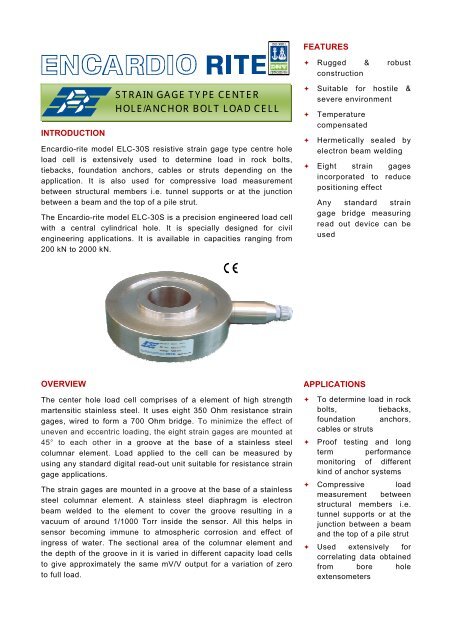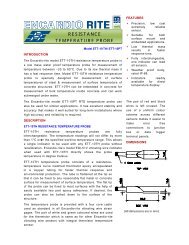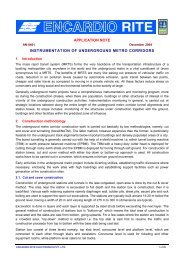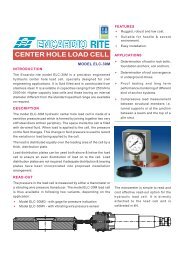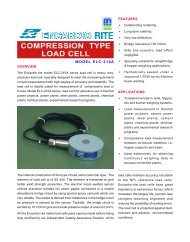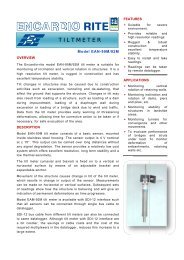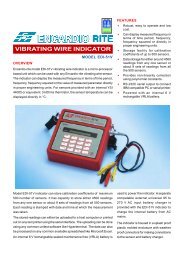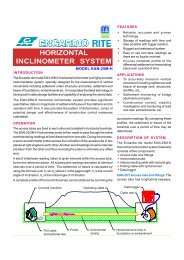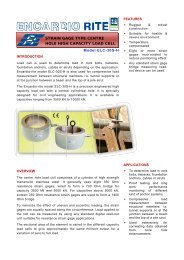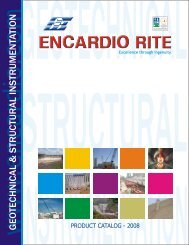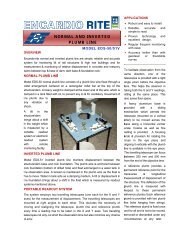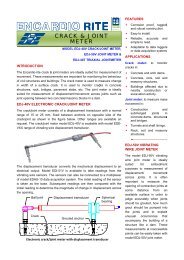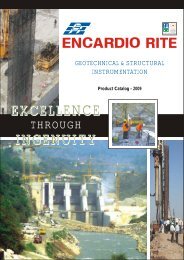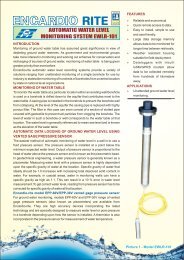Model ELC-30S - Encardio Rite
Model ELC-30S - Encardio Rite
Model ELC-30S - Encardio Rite
You also want an ePaper? Increase the reach of your titles
YUMPU automatically turns print PDFs into web optimized ePapers that Google loves.
FEATURESRugged&constructionrobustSTRAIN GAGE TYPE CENTERHOLE/ANCHOR BOLT LOAD CELL<strong>Model</strong><strong>ELC</strong>-<strong>30S</strong>INTRODUCTION<strong>Encardio</strong>-rite model <strong>ELC</strong>-<strong>30S</strong> resistive straingage typecentre holeload cell is extensively used to determine load in rock bolts,tiebacks, foundation anchors, cables or struts depending on theapplication.It is alsoused forcompressive load measurementbetween structural members i.e. tunnel supports or at the junctionbetween a beam and the top of a pile strut.The <strong>Encardio</strong>-rite model <strong>ELC</strong>-<strong>30S</strong>is a precision engineered load cellwith a central cylindrical hole. It is specially designed for civilengineeringg applications. It is available in capacities ranging from200 kN to 2000 kN.Suitable for hostile &severe environmentTemperaturecompensatedHermeticallysealed byelectron beamweldingEightstraingagesincorporatedto reduceepositioning effectAnystandardstraingage bridge measuringread out device can beusedOVERVIEWThe center hole load cell comprises of a element of high strengthmartensitic stainless steel. It uses eight 350Ohm resistance straingages, wired to form a 700 Ohmbridge. Tominimize the effect ofuneven andeccentric loading, theeight strain gages aremounted at45° to each other in a groove at the base of a stainless steelcolumnar element. Load applied to the cell can be measured byusing any standard digital read-out unit suitable for resistance straingage applications.The strain gages are mounted in a groove atthe base of a stainlesssteel columnar element. A stainless steel diaphragmis electronbeam welded to the element tocover thegroove resulting in avacuum of around 1/1000 Torr inside the sensor. All this helps insensor becoming immune to atmosphericcorrosion and effect ofingress of water. The sectional area of thecolumnar element andthe depth of the groove in it is varied in different capacity load cellsto give approximatelythe same mV/V outpufor a variation of zeroto full load.APPLICATIONS To determine load in rockbolts,tiebacks,foundationanchors,cables or strutsProof testing and longtermperformanceemonitoringofdifferentkind of anchorsystemsCompressiveloadmeasurementbetweenstructural members i.e.tunnel supports or at thejunction between a beamandthe top ofa pile struttUsedextensivelyforcorrelating data obtainedfromboreholeextensometerss
DIMENSIONSORDERING INFORMATIONHD2D1<strong>Model</strong><strong>ELC</strong>-<strong>30S</strong>- X/YCapacity kN/IDTYPICAL INSTALLATIOND385 (appr.)SPECIFICATIONSTypeResistive straingageRange (kN/IDmm) 200/40, 500/52, 1000/78,1000/105, 1500/85, 1500/130,2000/105, 2000/155 or asspecifiedOver range capacity 150 %Calibration accuracy ± 0.25 % fsLoad distribution plateLoad cellBearing plateSeating padNon-linearity± 1 % fsOutput2 mV/V ± 10 %Excitation10 V DC (max. 20 V DC)Terminal resistanceInput770 Ohm ± 5 %Output700 Ohm ± 1 %Temperaturee limit -20 to 80°CCable connectionSix pin glass tometal seal*All specifications subject to change withoutt prior notice.AnchorRockCapacity kN200Centre hole load cellD1 D2D3mm mmmm40 60155Ht. Wt.mm kg40 5PlateT mm23Bearing plateOD IDWt.mmmm kg155 116 2Load distributionplateOD IDmm mmm75 40Wt.kg1500100052 7815578 116 20040 540 73545155 116 2.5200 150 598 52135 781.53.51000105 138 22540 845225 172 6155 105 4150085 130 22555 1255225 165 8150 855.51500130 165 26055 14. .5 55260 200 9.5180 130 5.52000105 160 26055 1665260 195 12180 105 92000155 192 26055 12. .5 65260 226 7210 155 8.5ENCARDIO-RITE ELECTRONICS PVT. LTD.A-7Industrial Estate, Talkatora Road, Lucknow, UP-226011, IndiaP +91 522 2661040, F +91 522 2662403, geotech@enccardio.comInternational: P +91 522 2661044, www.encardioo.comDATA SHEET 1102-12 R02


